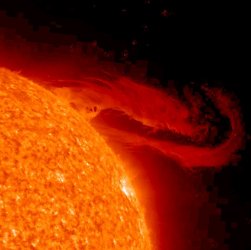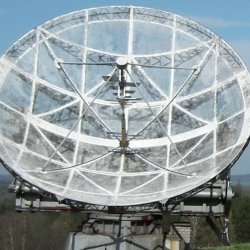Solar physics department
The Solar Physics Department studies our nearest star, the Sun, particularly the active phenomena in the solar atmosphere. This includes solar flares as well as accompanying heliospheric effects. Large-scale solar activity, evolution of solar active regions, the structure and evolution of sunspots and filaments, flare-energy storage, release and transport are studied. The research of the Solar Department can be characterized as a combination of solar observations in optical, radio and X-ray wavebands, analysis and interpretations of data, and theoretical research with extensive numerical modeling of the processes under study. All these activities are based on close colaboration with number of countries worldwide. This colaborations include exchange of various data and their theoretical interpretation, as well as our participation in some of the ground-based and space projects (e.g., Solar Orbiter or Juice).
Solar department is involved in realisation of two infrastructures that are on the Czech national roadmap of large research infrastructures. Those infrastructures are the European solar telescope and ALMA.
Recent publications
 The bright heads of sunspot penumbral filaments, penumbral grains, show apparent horizontal motions inward, toward the umbra, or outward, away from the umbra. Penumbral grains are locations of rising hot gas from sub-photospheric layers. We used spectropolarimetric observations of five sunspot penumbrae to compare magnetic inclinations inside penumbral grains with those in their surroundings. We found that approximately a half of the inward-moving grains have a magnetic inclination larger than the inclination in their surroundings and a half of the outward-moving grains have an inclination smaller than the surrounding one. The opposite relation of inclinations is observed in only one fifth of the penumbral grains. We conclude that there is a statistical relation between the direction of apparent motions of penumbral grains and the inclination of magnetic field in sunspot penumbra.
The bright heads of sunspot penumbral filaments, penumbral grains, show apparent horizontal motions inward, toward the umbra, or outward, away from the umbra. Penumbral grains are locations of rising hot gas from sub-photospheric layers. We used spectropolarimetric observations of five sunspot penumbrae to compare magnetic inclinations inside penumbral grains with those in their surroundings. We found that approximately a half of the inward-moving grains have a magnetic inclination larger than the inclination in their surroundings and a half of the outward-moving grains have an inclination smaller than the surrounding one. The opposite relation of inclinations is observed in only one fifth of the penumbral grains. We conclude that there is a statistical relation between the direction of apparent motions of penumbral grains and the inclination of magnetic field in sunspot penumbra.
 Morphology of Solar Type II Bursts Caused by Shock Propagation through Turbulent and Inhomogeneous Coronal Plasma
Morphology of Solar Type II Bursts Caused by Shock Propagation through Turbulent and Inhomogeneous Coronal Plasma
We report radio observations of type II burst which has enormously rich and complex spectral morphology. We have exploited its herringbone pattern to study electron density turbulence in the solar corona. For the first time, we obtained properties of the density turbulence in the coronal streamer. This research copes with a relevant task in the physics of solar plasma – probing properties of density turbulence in the corona in a routine way.
A. Koval, et al. 2023, The Astrophysical Journal, 952, id.51
 First Metis Detection of the Helium D3 Line Polarization in a Large Eruptive Prominence
First Metis Detection of the Helium D3 Line Polarization in a Large Eruptive Prominence
Space coronagraph Metis on ESA's Solar Orbiter was developed by Italian-German-Czech consortium. It is capable of observing the solar corona in the visible light and in Lyman-alpha line simultaneously for the first time. We present unique observations of a large eruptive prominence and demonstrate unambiguous detection of the neutral-helium D3 line emission. We show how the prominence appears in the polarized light and investigate potential of Metis to detect prominence magnetic fields.
P. Heinzel, et al. 2023, The Astrophysical Journal Letters, 957, 10H
 On the Physical Nature of the so-Called Prominence Tornadoes
On the Physical Nature of the so-Called Prominence Tornadoes
While the name ‘prominence tornadoes’ suggests violent rotational dynamics, the analogy with a tornado strongly collides with the usual paradigm of the magnetic structure of solar prominences. In this comprehensive review, we resolved this long-standing paradox. We concluded that ‘prominence tornadoes’ do not differ from other stable prominences. The impression of the column-like silhouettes and helical motions is just a consequence of projection effects combined with small-scale dynamics.
S. Gunár, et al. 2023, Space Science Reviews 219:33
Observations
- Solar Radio Telescopes (Data from the radio telescopes located at the Ondřejov observatory.)
- Solar Activity Monitoring and Forecasting (Data from the solar patrol service located at the Ondřejov observatory.)
- Multichannel Flare Spectrograph (Data from the multichannel spectrograph located at the Ondřejov observatory.)
- Satellite X-Ray Data (Data from Hard X-Ray Spectrometer, Czech-made instrument onboard the MTI satellite.)
Software and synthetic data
- KAPPA Package (Synthesis of optically thin emission lines and continuum spectra for solar and stellar coronae for the non-Maxwellian kappa-distributions.)
- PORTA (A three-dimensional multilevel radiative transfer code for modeling the intensity and polarization of spectral lines with massively parallel computers.)
- Grid of semi-empirical models (A grid of semi-empirical models of the solar photosphere and chromosphere to study the effects of various thermal stratifications on spectral lines.)
- Virtual Mission Laboratory Portal (Web application allowing access to kinetic simulations of space plasma.)
The department has four working groups
Physics of solar flares and prominences
 The group focuses on research of bright and energetic phenomena, including solar filaments and prominences, flares/CME, their mutual relationships, but also on physics of the solar corona and transition region. The primary goals include understanding of the magnetic flux ropes, and also mechanisms of solar eruptions and coronal heating. To this end, our researchers use a variety of numerical models and/or multiwavelength observations (from X-rays to radio) performed by space-borne and ground-based instruments. Group members also participate in proposing new instrumentation and observing campaigns.
The group focuses on research of bright and energetic phenomena, including solar filaments and prominences, flares/CME, their mutual relationships, but also on physics of the solar corona and transition region. The primary goals include understanding of the magnetic flux ropes, and also mechanisms of solar eruptions and coronal heating. To this end, our researchers use a variety of numerical models and/or multiwavelength observations (from X-rays to radio) performed by space-borne and ground-based instruments. Group members also participate in proposing new instrumentation and observing campaigns.
Part of this working group is also the Solar Patrol Service, which provides a daily overview of solar activity in the form of drawings of the solar photosphere and synoptic images. Another task of the Solar Patrol is to issue weekly and daily forecasts of solar activity.
Head: Jaroslav Dudík
Scientists: Arkadiusz Berlicki, Elena Dzifčáková, František Fárník, Vlastislav Feik, Stanislav Gunár, Petr Heinzel, Jana Kašparová, Dieter Nickeler, Martina Pavelková, Maciej Zapiór, Alena Zemanová
Structure and physics of the solar atmosphere
 The research goal of the group is to understand the physical conditions and processes in the solar atmosphere. It focuses on both active and quiescent regions of the atmosphere and particularly on sunspots. Using numerical models and analysis of spectroscopic and spectro-polarimetric observations of number of spectral lines that form at different layers of the solar atmosphere, members of the group aim to advance our understanding of the processes that shape the Sun's atmosphere. The group is involved in the development of the large European solar telescopes in the Canary Islands. In particular, it is currently involved in the realisation of the European Solar Telescope (EST).
The research goal of the group is to understand the physical conditions and processes in the solar atmosphere. It focuses on both active and quiescent regions of the atmosphere and particularly on sunspots. Using numerical models and analysis of spectroscopic and spectro-polarimetric observations of number of spectral lines that form at different layers of the solar atmosphere, members of the group aim to advance our understanding of the processes that shape the Sun's atmosphere. The group is involved in the development of the large European solar telescopes in the Canary Islands. In particular, it is currently involved in the realisation of the European Solar Telescope (EST).
Head: Jiří Štěpán
Scientists: Jose Iván Campos Rozo, Marta García Rivas, Jan Jurčák, Michal Sobotka, Michal Švanda,
Heliosphere and space weather
 The group studies physical processes in the solar wind using in situ spacecraft observations, numerical simulations and theoretical analyses. It concentrates on properties of solar wind particles (electrons & ions) and their interactions with waves, turbulence, and nonlinear structures. Furthermore, it investigates interactions between the solar wind and solar system planets and moons as well analogic interactions between moons and planetary magnetosperes.
The group studies physical processes in the solar wind using in situ spacecraft observations, numerical simulations and theoretical analyses. It concentrates on properties of solar wind particles (electrons & ions) and their interactions with waves, turbulence, and nonlinear structures. Furthermore, it investigates interactions between the solar wind and solar system planets and moons as well analogic interactions between moons and planetary magnetosperes.
Head: Petr Hellinger
Scientists: Štěpán Štverák, Marek Vandas
Group of solar radioastronomy
 The working group studies physical properties of the solar atmosphere and processes there through analysis of solar radio data obtained in the wide range of wavelengths from decimeters to millimeters. At the Ondrejov observatory the group operates several solar radio telescopes running at decimetric wavelengths. The group includes members of the Atacama Large Millimeter/submillimeter Array Regional Centre (ALMA ARC-CZ) Czech node, which runs since 2016 and supports the ALMA user community of Central and Eastern Europe. The Czech ARC node provides scientific and technical support in the field of solar and (extra) galactic research with ALMA.
The working group studies physical properties of the solar atmosphere and processes there through analysis of solar radio data obtained in the wide range of wavelengths from decimeters to millimeters. At the Ondrejov observatory the group operates several solar radio telescopes running at decimetric wavelengths. The group includes members of the Atacama Large Millimeter/submillimeter Array Regional Centre (ALMA ARC-CZ) Czech node, which runs since 2016 and supports the ALMA user community of Central and Eastern Europe. The Czech ARC node provides scientific and technical support in the field of solar and (extra) galactic research with ALMA.
Head: Artem Koval
Scientists: Miroslav Bárta, Yi Chai, Marian Karlický, Wenjuan Liu
 Contact
Contact
Department head: Jan Jurčák
Deputy head: Jana Kašparová
Secretary: Alice Chytrová
e-mail: alchytr@asu.cas.cz
tel.: +420 323 620 146
Address: Fričova 298, 251 65 Ondřejov, CZ